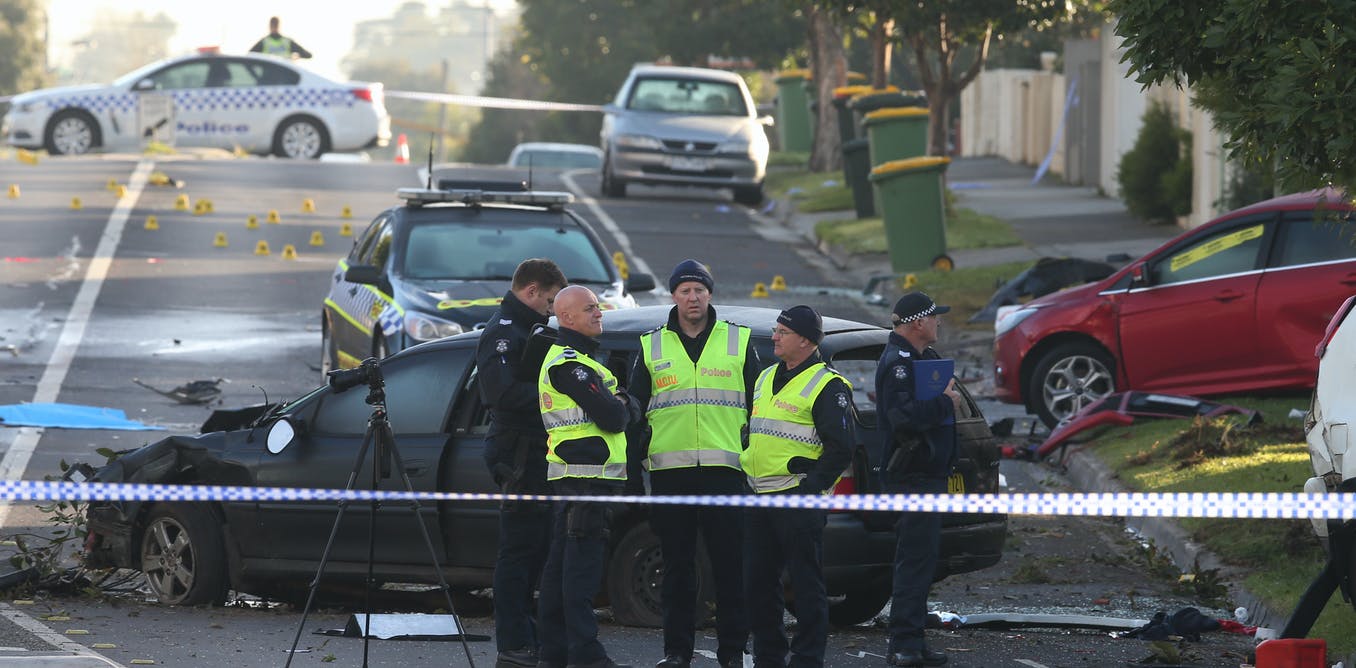Curious Kids: is it more dangerous for police to pursue a suspect than to call off the pursuit?

Curious Kids is a series for children. Send your question to curiouskids@theconversation.edu.au. You might also like the podcast Imagine This, a co-production between ABC KIDS listen and The Conversation, based on Curious Kids.
Is it more dangerous for police to pursue a suspect than to call off the pursuit? – Hugo, age 12, Melbourne.
There is no simple answer to your question. Police officers do a difficult job – every day they are faced with dangerous situations. One of the most difficult situations a police officer can face is being involved in a pursuit.
I was a police officer in Queensland for 28 years and spent some years in the traffic branch as a motorcyclist, before I later became a detective. When I was in the traffic branch, I was involved in many pursuits. I also had to do accident investigation duties where I had to investigate serious and even fatal accidents.
À lire aussi :
Curious Kids: who were the Spartans?
Why and when can police start a pursuit?
Police are allowed to break certain traffic laws – such as going over the speed limit and going through red lights – if they are pursuing a suspect. But there are conditions. For instance, most police services require the police vehicle to come to a stop before going through the red light, even when they have their lights and siren on.
Generally, though, the police are not allowed to drive dangerously when pursuing a suspect. In fact, it is a criminal offence. So if the pursuit becomes dangerous, the police are supposed to stop chasing the suspect. Unfortunately that doesn’t always happen, and people can die as a result of a police pursuit.
Police are trained to drive fast in case they need to pursue a suspect. But initiating a pursuit is a very serious thing. It’s a difficult decision to make, and often has to happen very quickly and under a lot of pressure.
Who decides if the police pursuit continues?
Once a pursuit is initiated, police need to radio their operations centre and advise that they are in pursuit of a suspect. They will describe the actions of the suspect, speeds, location, and any dangerous acts committed by the suspect.
Once the police officers in the car call in the pursuit, a more senior officer at the operations centre will make a decision on when to allow the pursuit to continue and when to stop it.
The senior officer will consider many factors, including:
danger to the public
the seriousness of the offence that led to the pursuit being started
whether the police know the identity of the suspect
the type of police vehicle involved
the time of day
weather conditions.
If the senior officer says to end the pursuit, all the police pursuing the suspect must stop chasing them. Most police services have policies that guide police officers on how to conduct pursuits.
How common are police pursuits?
In Australia each year there are more than 3,000 police pursuits. Fewer than 1% of those pursuits result in a fatal accident. Most pursuits start as the result of minor offences.
An Australian Institute of Criminology study identified that:
in 2009 there were 3,806 pursuits
in 2010 there were 3,865 pursuits
in 2011 there were 4,175 pursuits across Australia.
The study concluded that:
…males under the age of 25 accounted for a large proportion of individuals who died as a result of a police pursuit and it was found that almost nine in every 10 alleged offenders who died driving the vehicle being pursued had consumed alcohol, drugs or both prior to the incident. Findings also highlighted that pursuit fatalities were more likely to have occurred late at night and in urban areas. While the average speeds of vehicles involved in fatal pursuits have increased slightly, the average duration of fatal pursuits has declined considerably.
The study found that between 2000 and 2011 there were 218 deaths in 185 crashes. Of those killed, 38% were bystanders, while the other 62% of deaths involved the driver or passenger of the pursued vehicle.
Traffic matters and stolen motor vehicles were the most common offences that led to a fatal pursuit.
The same study concluded:
Finally, this study revealed that police agencies are very aware of the risks associated with pursuits and restrictive reforms to pursuit policies have been introduced in some jurisdictions.
These restrictions mean police are generally only supposed to pursue suspects for more serious offences and only if there is no danger to the police or public.
This is because police have been criticised for pursuits that have ended with people – including innocent bystanders – being killed.
Pursuits are really difficult situations for police. As a Victoria Police report on pursuits said:
The fallout public opinion and media commentary that follows a pursuit indicates it truly is the case of damned if you do, damned if you don’t.
À lire aussi :
Curious Kids: what’s the history of aircraft squawk codes and how do they work?
Hello, curious kids! Have you got a question you’d like an expert to answer? Ask an adult to send your question to us. You can:
* Email your question to curiouskids@theconversation.edu.au
* Tell us on Twitter by tagging @ConversationEDU with the hashtag #curiouskids, or
* Tell us on Facebook
CC BY-ND
Please tell us your name, age and which city you live in. You can send an audio recording of your question too, if you want. Send as many questions as you like! We won’t be able to answer every question but we will do our best.

Terry Goldsworthy ne travaille pas, ne conseille pas, ne possède pas de parts, ne reçoit pas de fonds d'une organisation qui pourrait tirer profit de cet article, et n'a déclaré aucune autre affiliation que son organisme de recherche.







